The Hubble European Space Agency Information Centre (HEIC) is a science communication office, established at the Space Telescope - European Coordinating Facility (ST-ECF) in Munich, Germany late in 1999. This initiative was taken so as to fulfil the NASA/ESA Hubble Space Telescope (HST) outreach and education tasks for the European Space Agency (ESA), as outlined in an agreement between NASA and ESA.
Over the past few years HEIC has become a very distinguished communication office of experts using the newest software and techniques. The European Hubble office has produced large amounts of astronomical material suitable both for educational purposes and wider public consumption. HEIC provides a well-assorted archive that is publicly available on its web page.
The work is centred on the production of news and photo releases that highlight interesting Hubble science results and images. These are often European in origin, and so not only increase the awareness of ESA's Hubble share (15%), but the contribution of European scientists to the observatory. Furthermore, the group produces video releases, innovative educational material, CD-ROMs, brochures, posters, as well as DVDs and museum information kiosks, and much more.
The Hubble Information Centre is headed by the science communication specialist Lars Lindberg Christensen and the lead graphic designer is Martin Kornmesser.

The European Space Agency is an intergovernmental organisation of 22 member states dedicated to the exploration of space. Established in 1975 and headquartered in Paris, ESA has a worldwide staff of about 2,200 in 2018 and an annual budget of about €7.2 billion in 2022.

The Hubble Space Telescope is a space telescope that was launched into low Earth orbit in 1990 and remains in operation. It was not the first space telescope, but it is one of the largest and most versatile, renowned both as a vital research tool and as a public relations boon for astronomy. The Hubble telescope is named after astronomer Edwin Hubble and is one of NASA's Great Observatories. The Space Telescope Science Institute (STScI) selects Hubble's targets and processes the resulting data, while the Goddard Space Flight Center (GSFC) controls the spacecraft.

The Space Telescope Science Institute (STScI) is the science operations center for the Hubble Space Telescope (HST), science operations and mission operations center for the James Webb Space Telescope (JWST), and science operations center for the Nancy Grace Roman Space Telescope. STScI was established in 1981 as a community-based science center that is operated for NASA by the Association of Universities for Research in Astronomy (AURA). STScI's offices are located on the Johns Hopkins University Homewood Campus and in the Rotunda building in Baltimore, Maryland.
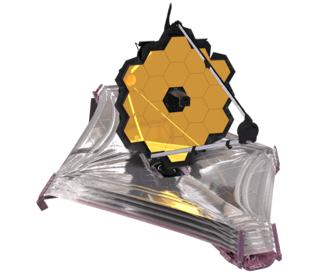
The James Webb Space Telescope (JWST) is a space telescope designed primarily to conduct infrared astronomy. As the largest optical telescope in space, its high infrared resolution and sensitivity allow it to view objects too early, distant, or faint for the Hubble Space Telescope. This is expected to enable a broad range of investigations across the fields of astronomy and cosmology, such as observation of the first stars and the formation of the first galaxies, and detailed atmospheric characterization of potentially habitable exoplanets.
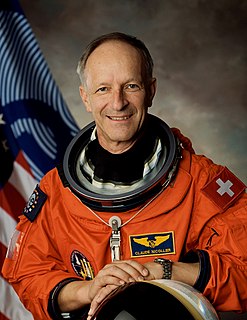
Claude Nicollier is the first astronaut from Switzerland. He has flown on four Space Shuttle missions. His first spaceflight (STS-46) was in 1992, and his final spaceflight (STS-103) was in 1999. He took part in two servicing missions to the Hubble Space Telescope. During his final spaceflight he participated in a spacewalk, becoming the first European Space Agency astronaut to do so during a Space Shuttle mission. In 2000 he was assigned to the Astronaut Office Extravehicular Activity Branch, while maintaining a position as Lead ESA Astronaut in Houston. Nicollier retired from ESA in April 2007.

John Mace Grunsfeld is an American physicist and a former NASA astronaut. He is a veteran of five Space Shuttle flights and has served as NASA Chief Scientist. His academic background includes research in high energy astrophysics, cosmic ray physics and the emerging field of exoplanet studies with specific interest in future astronomical instrumentation. After retiring from NASA in 2009, he served as the Deputy Director of the Space Telescope Science Institute in Baltimore, Maryland. In January 2012, he returned to NASA and served as associate administrator of NASA's Science Mission Directorate (SMD). Grunsfeld announced his retirement from NASA in April 2016.

NASA's series of Great Observatories satellites are four large, powerful space-based astronomical telescopes launched between 1990 and 2003. They were built with different technology to examine specific wavelength/energy regions of the electromagnetic spectrum: gamma rays, X-rays, visible and ultraviolet light, and infrared light.

The European Space Astronomy Centre (ESAC) near Madrid in Spain is the ESA's centre for space science. It hosts the science operation centres for all ESA astronomy and planetary missions together with their scientific archives. Past and present missions represented at ESAC include Akari, BepiColombo, Cassini–Huygens, Cluster, Exomars, Gaia, Herschel, Hubble, ISO, INTEGRAL, IUE, LISA Pathfinder, Mars Express, Planck, Rosetta, SOHO, Solar Orbiter, Venus Express, and XMM-Newton.
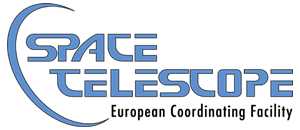
The Space Telescope – European Coordinating Facility (ST-ECF) was an institution which provided a number of support and service functions primarily for European observers of the NASA/ESA Hubble Space Telescope (HST). It was established in 1984 by the European Space Agency (ESA) and the European Southern Observatory (ESO), and was located at the ESO headquarters in Garching bei München, Germany. The ST-ECF ceased operations on 31 December 2010.
The Hubble Heritage Project was founded in 1998 by Keith Noll, Howard Bond, Forrest Hamilton, Anne Kinney, and Zoltan Levay at the Space Telescope Science Institute. The team released, on an almost monthly basis, pictures of celestial objects like planets, stars, galaxies and galaxy clusters.

The ESA/ESO/NASA FITS Liberator is a free software program for processing and editing astronomical science data in the FITS format to reproduce images of the universe. Version 3 and later are standalone programs; earlier versions were plugins for Adobe Photoshop. FITS Liberator is free software released under the BSD-3 license. The engine behind the FITS Liberator is NASA's CFITSIO library.
The ESO/ST-ECF Science Archive Facility is an electronic archive for astronomical data. It currently contains more than 40.0 Terabytes of scientific data obtained with the ESA/NASA Hubble Space Telescope (HST), with the ESO New Technology Telescope (NTT) and Very Large Telescope (VLT) and with the Wide Field Imager on the ESO/MPI 2.2m Telescope.
An association (astronomy) is a combined or co-added group of astronomical exposures from which cosmic rays have been removed. WFPC2 associations constitute one type of association and are tools in the Hubble Space Telescope (HST) archive for using data from the Wide Field and Planetary Camera 2 (WFPC2). Associations were introduced in the HST archive at the beginning of 1998. Since then, astronomers have been able to retrieve on-the-fly re-calibrated co-added WFPC2 images that have already been cleaned of cosmic rays from the Space Telescope European Coordinating Facility (ST-ECF), the Canadian Astronomy Data Centre (CADC) and Space Telescope Science Institute (STScI) archives.
Robert (Bob) Fosbury is currently an emeritus astronomer at the European Southern Observatory and an honorary professor at the Institute of Ophthalmology at UCL. He is an astronomer who worked for 26 years at the European Space Agency (ESA) as part of ESA's collaboration with NASA on the Hubble Space Telescope (HST) project at ST-ECF. Based at the European Southern Observatory (ESO) near Munich in Germany, Fosbury joined this initiative in 1985, more than 5 years before launch. During the latter part of this period, Bob served on NASA's Ad Hoc Science Working Group and ESA's Study Science Team as they developed the instrument concepts for the James Webb Space Telescope, the next-generation space observatory.
Martin Kornmesser is a graphic designer working at the ESA/NASA Hubble European Space Agency Information Centre (HEIC) in Munich/Garching. He obtained his degree in graphics design in Munich in 1989. Kornmesser has actively pioneered the exploration of the world of computer graphics. In 1990 he was the co-founder of the company ART-M, where he created illustrations, wall-paintings and all kinds of graphics design before joining ESA's Hubble outreach group in 1999.
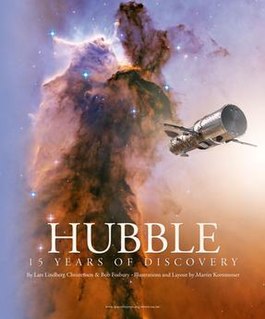
Hubble – 15 Years of Discovery (ISBN 0-387-28599-7) is a book that formed part of the European Space Agency's 15th anniversary celebration activities for the 1990 launch of the NASA/ESA Hubble Space Telescope. Its main emphasis is on the exquisite Hubble images that have enabled astronomers to gain entirely new insights into the workings of a huge range of different astronomical objects. Hubble has provided the visual overview of the underlying astrophysical processes taking place in these objects, ranging from planets in the Solar System to galaxies in the young Universe. This book shows the close relationship between the results of great scientific value and of eye-catching beauty and artistic potential.

Katherine Megan McArthur is an American oceanographer, engineer, and NASA astronaut. She has served as a Capsule Communicator (CAPCOM) for both the Space Shuttle and International Space Station (ISS). Megan McArthur has flown one space shuttle mission, STS-125 and one SpaceX mission, SpaceX Crew-2 on Crew Dragon Endeavour. She is known as the last person to be hands on with the Hubble Space Telescope via the Canadarm. McArthur has served in a number of positions including working in the Shuttle Avionics Laboratory (SAIL). She is married to fellow astronaut Robert L. Behnken.
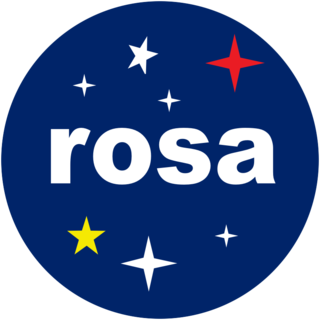
The Romanian Space Agency is a public institution with extra-budgetary funding which coordinates the national space technology research programs and space research-related activities. ROSA was founded in 1991 and is subordinated to the Ministry of Education.

The Swiss Space Office (SSO) is the federal government's competence centre for national and international space matters. In its role it cooperates closely with other federal offices and is responsible for the preparation and implementation of the policy and strategic orientations of the space domain in Switzerland. The SSO is part of the State Secretariat for Education, Research, and Innovation. The Head of the SSO is Dr. Renato Krpoun.

Euclid is a visible to near-infrared space telescope currently under development by the European Space Agency (ESA) and the Euclid Consortium. The objective of the Euclid mission is to better understand dark energy and dark matter by accurately measuring the acceleration of the universe. To achieve this, the Korsch-type telescope will measure the shapes of galaxies at varying distances from Earth and investigate the relationship between distance and redshift. Dark energy is generally accepted as contributing to the increased acceleration of the expanding universe, so understanding this relationship will help to refine how physicists and astrophysicists understand it. Euclid's mission advances and complements ESA's Planck telescope. The mission is named after the ancient Greek mathematician Euclid of Alexandria.
















